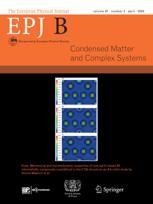Considering disorder and cooperative effects in photon escape rates from atomic gases
Investigating more complex models of photon escape rates from cold atomic gases could help researchers learn more about light-matter interactions.
New York | Heidelberg, 26 February 2021
 Whilst a great deal of research has studied the rates of photons escaping from cold atomic gases, these studies have used a scalar description of light leaving some of its properties untested. In a new paper published in EPJ B Louis Bellando, a post-doctoral researcher at LOMA, University of Bordeaux, France, and his coauthors - Aharon Gero and Eric Akkermans, Technion-Israel Institute of Technology, Israel, and Robin Kaiser, Université Côte d'Azur, France - aim to numerically investigative the roles of cooperative effects and disorder in photon escape rates from a cold atomic gas to construct a model that considers the vectorial nature of light. Thus, the study accounts for properties of light, previously neglected.
Whilst a great deal of research has studied the rates of photons escaping from cold atomic gases, these studies have used a scalar description of light leaving some of its properties untested. In a new paper published in EPJ B Louis Bellando, a post-doctoral researcher at LOMA, University of Bordeaux, France, and his coauthors - Aharon Gero and Eric Akkermans, Technion-Israel Institute of Technology, Israel, and Robin Kaiser, Université Côte d'Azur, France - aim to numerically investigative the roles of cooperative effects and disorder in photon escape rates from a cold atomic gas to construct a model that considers the vectorial nature of light. Thus, the study accounts for properties of light, previously neglected.
“Our study focuses on light propagation in cold atomic gases, in which atoms hardly move. On their way out of the gas, photons undergo multiple scattering by the atoms,” Bellando says. “Roughly speaking, the greater the number of these scattering events - the longer it takes the photons to leave the gas, and thus the smaller their escape rates. This classical description fits the so-called radiation trapping, which occurs, for example, when light undergoes a random walk in a glass of milk.”
When taking into account interference and quantum mechanical effects, two mechanisms affect these escape rates: Anderson localisation arising from interference effects in the presence of disorder, and Dicke’s superradiance - cooperative effects stemming from light-mediated interactions between the atoms.
Numerically studying photon escape rates from a three-dimensional cloud of cold atoms allowed the team to consider if there were any marked differences between the behaviour in the simple scalar case - giving a single value to every point in a region - and the more complex vector case that assigns magnitude and direction to every point in a given area.
One of the biggest surprises encountered by the researchers as they collected their results was how well vector field observations agreed with scalar field tests. “Surprisingly, we found no significant difference between the scalar and vectorial models, and in both cases, the dominant mechanism was cooperativity,” says Bellando. “Now we know that the scalar model constitutes an excellent approximation when considering photon escape rates from atomic gases.”
Because the scalar model is much simpler than the vectorial one, the similarity between the two means that in the case of photon escape rates models can use scalar fields rather than vector fields without the risk of losing substantial information.
“Light-matter interaction is an exciting field of research, both theoretically and experimentally,” Bellando concludes. “Advances in this area may have a significant impact on other emerging fields, such as quantum computing.”
References: L. Bellando, A. Gero, E. Akkermans, R. Kaiser (2021), Roles of Cooperative Effects and Disorder in Photon Localization: The Case of a Vector Radiation Field, European Physical Journal B 94:49, DOI: 10.1140/epjb/s10051-021-00054-6
Further Information
For more information visit: www.epj.org
Services for Journalists
The full-text article is available here.
Contact
Sabine Lehr | Springer | Physics Editorial Department
tel +49-6221-487-8336 | sabine.lehr@springer.com
